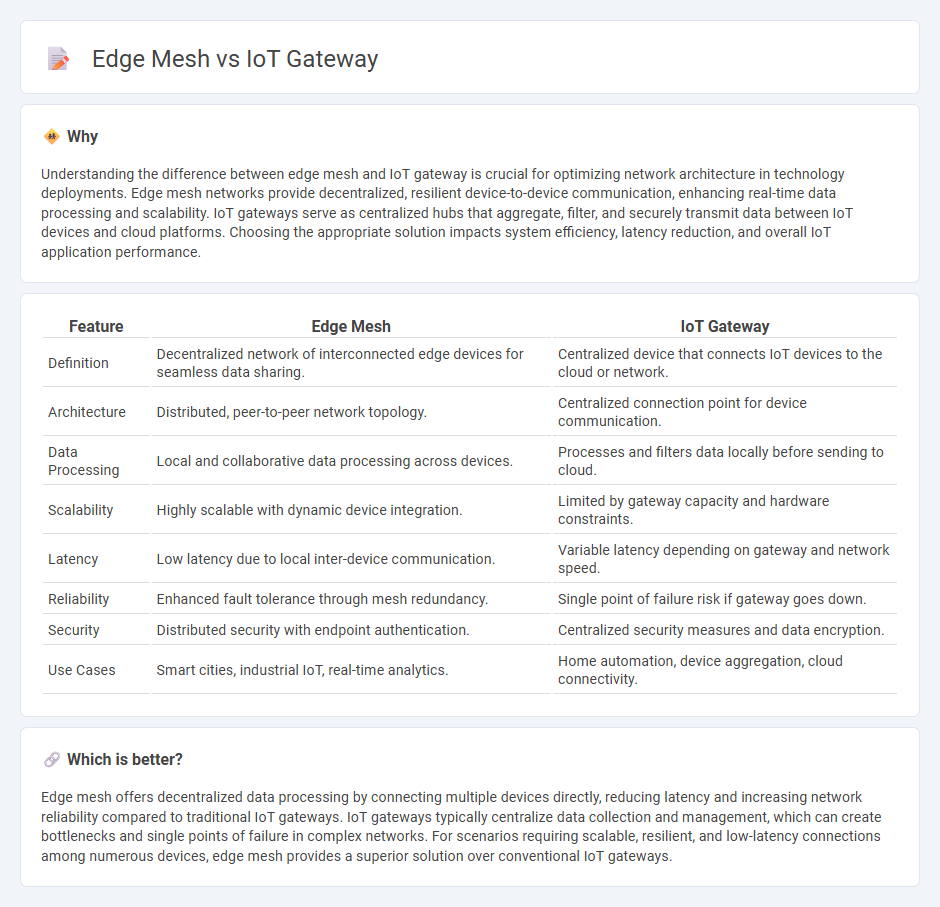
Edge mesh networks offer decentralized communication by enabling devices to connect directly with each other, reducing latency and enhancing reliability in IoT systems. IoT gateways act as centralized hubs, managing data flow between edge devices and cloud platforms while providing security and protocol translation. Explore the advantages and applications of edge mesh versus IoT gateways to optimize your technology infrastructure.
Why it is important
Understanding the difference between edge mesh and IoT gateway is crucial for optimizing network architecture in technology deployments. Edge mesh networks provide decentralized, resilient device-to-device communication, enhancing real-time data processing and scalability. IoT gateways serve as centralized hubs that aggregate, filter, and securely transmit data between IoT devices and cloud platforms. Choosing the appropriate solution impacts system efficiency, latency reduction, and overall IoT application performance.
Comparison Table
| Feature | Edge Mesh | IoT Gateway |
|---|---|---|
| Definition | Decentralized network of interconnected edge devices for seamless data sharing. | Centralized device that connects IoT devices to the cloud or network. |
| Architecture | Distributed, peer-to-peer network topology. | Centralized connection point for device communication. |
| Data Processing | Local and collaborative data processing across devices. | Processes and filters data locally before sending to cloud. |
| Scalability | Highly scalable with dynamic device integration. | Limited by gateway capacity and hardware constraints. |
| Latency | Low latency due to local inter-device communication. | Variable latency depending on gateway and network speed. |
| Reliability | Enhanced fault tolerance through mesh redundancy. | Single point of failure risk if gateway goes down. |
| Security | Distributed security with endpoint authentication. | Centralized security measures and data encryption. |
| Use Cases | Smart cities, industrial IoT, real-time analytics. | Home automation, device aggregation, cloud connectivity. |
Which is better?
Edge mesh offers decentralized data processing by connecting multiple devices directly, reducing latency and increasing network reliability compared to traditional IoT gateways. IoT gateways typically centralize data collection and management, which can create bottlenecks and single points of failure in complex networks. For scenarios requiring scalable, resilient, and low-latency connections among numerous devices, edge mesh provides a superior solution over conventional IoT gateways.
Connection
Edge mesh networks enhance IoT gateway efficiency by enabling decentralized data processing and communication among connected devices. IoT gateways serve as critical nodes that aggregate data from multiple sensors and devices within the edge mesh, reducing latency and bandwidth usage. This integration supports real-time analytics and improves the scalability of Internet of Things deployments.
Key Terms
Data Aggregation
IoT gateways centralize data aggregation by collecting and processing information from multiple devices before sending it to the cloud, reducing latency and bandwidth usage. Edge mesh networks distribute data processing across interconnected nodes at the network edge, enhancing scalability and fault tolerance while maintaining real-time data flow. Explore how these architectures optimize IoT deployments for different industrial applications.
Local Processing
IoT gateways enable local processing by aggregating data from multiple edge devices, reducing latency and bandwidth usage compared to cloud-based solutions. Edge mesh networks distribute computing power across interconnected nodes, enhancing real-time data analysis and fault tolerance at the network edge. Explore how local processing differences between IoT gateways and edge mesh architectures impact your IoT deployments.
Network Topology
IoT gateway architecture typically employs a star topology, centralizing data traffic through a single point for efficient management and security control, while edge mesh networks utilize a decentralized, peer-to-peer topology that enhances scalability, fault tolerance, and direct device communication. Network topology in IoT gateways favors simplicity and easier integration with cloud services, whereas edge mesh enables dynamic routing and localized data processing to reduce latency and bandwidth usage. Explore more to understand which network topology best suits your IoT deployment needs.
Source and External Links
What is an IoT Gateway? - Supermicro - An IoT gateway is a critical bridge between IoT devices and the cloud that performs functions such as protocol translation, data aggregation and filtering, secure communication, and device management to ensure seamless data flow and efficiency in IoT systems.
Internet of Things (IoT) Gateways - GeeksforGeeks - An IoT gateway enables communication between sensors/devices and the cloud by translating protocols, aggregating data, processing locally, filtering, and securing device communication, often using wireless or cellular links to conserve energy on sensor nodes.
What is an IoT Gateway? | Definition from TechTarget - IoT gateways route data bidirectionally between devices and the cloud, often perform edge computing to preprocess data, and support device management such as firmware updates, improving network efficiency and security.
 dowidth.com
dowidth.com